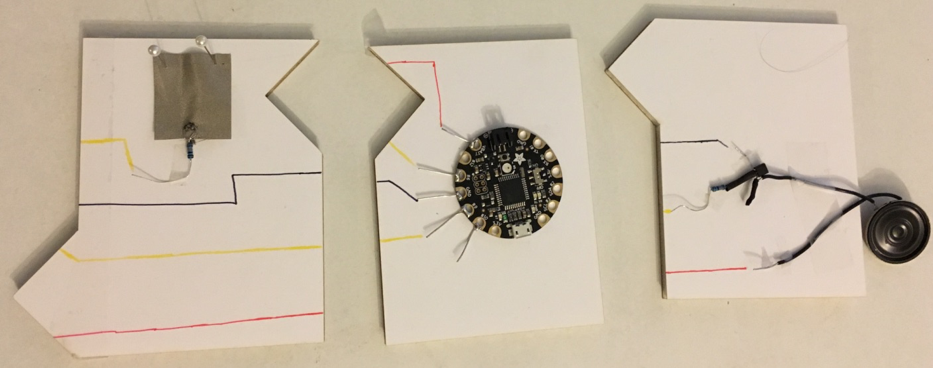Designing E-Textiles with Adults with Intellectual Disabilities
Taylor Gotfrid, Rochester Institute of Technology, tg3200@rit.eduKristen Shinohara, Rochester Institute of Technology, kristen.shinohara@rit.edu
Abstract
Electronic textiles, or e-textiles, are an emerging type of wearable and interactive technology that can gather information either actively (i.e. pressing a button) or passively (i.e. pulse rate), or act purely as an output (e.g. LEDs). Developing e-textile technology requires some familiarity with many different concepts, one of which is circuit design. Unfortunately, people with disabilities are rarely included in the design and development of e-textiles; methods to manipulate these wearable interactive technologies—such as ways to learn circuit design—are not accessible to disabled creators. In this research, we explored accessible processes to enable individuals with intellectual disabilities to create their own e-textiles. To make the circuit design process accessible, we introduced circuit design concepts via a "puzzle" metaphor and simplified the sewing process by modifying common components to decrease the level of fine motor control required to sew the circuit. We conducted a pilot study with two participants with intellectual disabilities where both participants successfully created their very own e-textile and provided feedback about the usability of the "circuit puzzle" and the form-factor of puzzle pieces.1. Introduction
Wearable technology, often referred to as wearables, are electronic technologies that have been incorporated into the clothes or accessories we wear, such as Google Glass or smartwatches. E-textiles are a type of wearable technology that uses fabrics or yarn as the base material on which electrical circuits are constructed. E-textiles can respond to both active (e.g. button press) and passive (e.g. pulse detection) inputs. E-textiles are an emerging technology with potential contributions to many fields such as health and well-being, artistic expression, and social interactions [1,6,7]. The unique and varied interactive modalities available with e-textiles make creation and use of these technologies well suited for diverse audiences. However e-textiles are not currently being explored with adults with intellectual disabilities.
Creating e-textiles requires knowledge from multiple domains such as electronics, programming, and sewing [4]. However, few research studies investigate how to make circuit design accessible to individuals with intellectual disabilities [5] and even fewer examine how to empower people with disabilities to assume a leading role in a technology’s design and creation process [8]. Research focusing on circuit prototyping with individuals with intellectual disabilities has primarily focused on children, not adults; our goal is to expand upon existing research and to explore ways to enable disabled adults design and create their own e-textile.
Participants in our pilot study successfully created their own e-textiles and developed a basic understanding of circuit design. At the end of the workshop, participants were able to describe to the researcher how their circuit worked.
2. Related Work
2.1 Empowerment Through Making
Makers are a group of consumers who buy electrical components or prototyping kits online who view making or Do-it-yourself (DIY) as a hobby. For members of this community, "making is not only about using new technologies, but also about the possibilities of what can be created" [8]. Meissner et al. discussed how the maker experience can empower those with disabilities when they are actively engaged in the making process [8]. In a study where participants with a variety of disabilities were introduced to 3D printers, laser cutters, and microcontrollers, participants attended workshops where they learned how to use the different technologies and in the final sessions participants defined and made their own item/object/work [8]. In addition, inclusive design methods encouraged visually impaired participants to be more confident in their ability to create personal and interactive e-textiles [3]. Both of these studies allowed participants to assume a new identity as a maker and embody a form of empowerment unique to the individual maker. We want to focus on including participants in as much of the design process as possible, and examine how creating their own e-textile reflects how they express their personality, ownership, and sense of empowerment.
2.2 Development of Circuit/Puzzle Idea
One barrier to making e-textiles is a fundamental understanding of basic circuitry, which can be a difficult and intimidating process for beginners [2]. Hollinworth et al. (2014) made a pre-existing children’s circuit designing kit accessible for people with learning disabilities by modifying pieces to have larger, and asymmetrical bases for easier handling and constrained matching. They added magnets—and the logic that same poles repel—to minimize incorrect connections. Participants found the larger blocks easier to handle, but had problems connecting components in the correct order [5].
In our study, we leveraged the puzzle paradigm to utilize physical constraints to relate logical relationships between the components’ order and its necessary electrical connections [5]. Thus, we constructed a circuit puzzle comprising three pieces where a single distinct electrical component was attached to individual pieces (See Figure 1). Made out of foamcore, each puzzle piece is shaped differently so they reinforce logical and constrained connections between the different electronic components. The unique puzzle shapes for each component requires that pieces can only be placed in a specific sequence.

3. Methodology
With IRB approval, we conducted a pilot session in June 2018 with two participants with intellectual disabilities from Cerebral Palsy Rochester (CP Rochester). CP Rochester is a day facility that assists and provides support for those with a range of disabilities and their families. Prior to the study, neither participant had any experience with circuit design or prototyping. We investigated how well-received the puzzle as circuit was for participants, the transferability of skills and knowledge from the circuit puzzle to e-textile construction, and participants’ receptiveness to creating their own e-textiles in general. Results from the pilot inform a larger research project focused on accessible e-textile development.
The study consisted of three sessions. In the first session, participants received an introduction to e-textiles and were instructed to choose the kind of e-textile they want to make. In the second session, participants learned basic circuitry concepts, connected their circuit puzzle, and got an opportunity to interact with their final working circuit. The researcher would turn the microcontroller on and then the participant could trigger their chosen input (button, tilt switch, or color sensor) and then see, feel, or hear the output; thereby directly observing how their circuit will function in their final e-textile. During this time participants are encouraged to openly explore their resulting circuit including "triggering" their input and observing the circuit puzzle more closely by holding, turning, or flipping it around to view it from other angles. In the final and third session participants sewed their circuit to the base fabric of their object to create the final e-textile.
In the first session participants are given an introduction to e-textiles, followed by a demonstration of a few home-made e-textiles that showcased the different inputs (capacitive touch button, tilt switch, and color sensor) and outputs (LEDs, sound) that participants will choose from for their own e-textile. Then we asked participants to choose the type of e-textile they wanted to make (e.g. bracelet, stuffed animal), to select fabric type or patterns to serve as their base fabric, to select inputs and outputs, and to describe how they wanted their circuit to function (e.g. after the button is pressed a short tune plays from the speaker).
Between sessions one and two the first author prepared the electrical components by gluing each to a uniquely shaped foamcore "puzzle piece" and programming the microcontroller. Pieces fit together to avoid incorrect connections [4]. Different colored lines drawn on the foamcore marked each component’s connection to ground, power, or other components (see Figure 1).
In the second session, participants created prototype versions of their e-textiles using the foamcore puzzle pieces. The researcher explained the basic electricity and how circuits worked, and how connecting wires sends electrical signals, or "talks", to the others. After the brief circuit design tutorial, participants constructed their own circuit puzzle, connecting the pieces with the alligator clips or conductive ink (See Figure 2). After the circuit was complete, a power source was connected and the participant could see and explore how their working circuit functioned. During this time participants were encouraged to trigger their input and to look, touch, hold, or physically interact with their circuit in whatever manner they desired. After the second session, the researcher made the e-textile bases for the participants (a bracelet and necklace pendant) and hot-glued the electrical components onto the fabrics.

Between sessions two and three the first author cut and sewed the parts of the e-textile that the participant would not be sewing (e.g. sewing snaps to the outside of the bracelet so the participant could wrap it around their wrist). Circuit components were hot-glued onto the fabric so the participant would not have to hold the component still while sewing. During the third session, participants will use the conductive thread to make all of the necessary electrical connections between all of the circuit’s components. If the components aren’t connected with some type of conductive material, such as conductive thread, the circuit won’t work. The researcher also modified each of the circuit components to make them easier for the participant to sew into their e-textile. Some circuit components, like the Gemma v2 — a common microcontroller used in e-textile projects—has holes to allow the microcontroller to be directly sewn into a project. However, the holes on microcontrollers and other circuit components designed specifically for e-textiles are small, and to ensure a good electrical connection typically the hole is sewn through several times. This task may be challenging for someone who has trouble with fine motor skills.
In the third and final session, participants were given their e-textile with each circuit component glued on to their selected fabric. They repeated the process from the second session to create the circuit, but used conductive thread on fabric instead of ink or alligator clips on foamcore. While sewing the circuit into their e-textile they referenced their "puzzle" circuit to recall how to connect the components. Afterwards, participants were asked about their experience working with e-textiles.
3.1 Data Analysis
Data was collected during each session via field notes and video recordings. After each session the researcher also recorded reflections on observations made during the session. Videos of each session were reviewed for additional observations not noted immediately after the session. Recordings were transcribed and analyzed for emerging themes. Analysis focused on participants’ ability to design and create their e-textile and their feedback about the circuit puzzle or the puzzle pieces. We also focused on positive or negative reactions while trying to complete their circuit puzzle, and when participants exhibited frustration or expressed the need for help.Findings
Overall the sessions confirmed that adults with intellectual disabilities could design and create their own e-textiles within the process we employed here. Specifically, participants were able to use knowledge gained from the workshop to implement into their own e-textile creation. In addition, exposure to the workshop encouraged enthusiasm among participants to learn more and they suggested other ways that e-textiles could be utilized.
In the second session both participants successfully made electrical connections by themselves or with minimal assistance. Participants requested assistance when the task required fine motor control, something with which both participants struggled. P2 was able to use conductive paint, but P1 did not have sufficient fine-motor control to hold and squeeze the conductive paint bottle or to separate the prongs of the alligator clips. Due to difficulty with fine-motor control, the researcher modified this portion of the session and acted as their "hands," connecting components based on P1’s guidance. By the end of the second session, both participants were able to accurately identify which part of their circuit was the microcontroller (or the "brain"), input, and output, and could successfully describe how the circuit components interacted.
P1 participant found the circuit puzzle easy while P2 found it to be more challenging. By the third session, both participants were able to reference their circuit puzzle to figure out how the next connection needed to be sewn for their e-textile. Similar to in the second session, P2 was able to sew her own e-textile but had trouble using tools that required fine motor control. Again, we modified the sewing process for P1, and the participant instructed the researcher to connect the components; the researcher did the stitching. By the end of the third session, both participants successfully created their own working e-textile circuit (See Figure 3).

Discussion
Both participants were able to successfully create their own e-textile circuit and enjoyed the workshop sessions. Neither participant had any previous exposure to e-textiles before this project, but by the end of the project both participants described potential uses for e-textiles. One participant considered how it might help her with her own disability. When the researcher asked P1 if they could think of any other ways that e-textiles could be used, she replied "They could be used to track her tics." She also responded that some of her other friends would also find this useful.
By the end of the study both participants reported they felt they would be able to create a new e-textile if given a kit and a circuit puzzle, although they expressed that a picture of the completed circuit would be helpful for reference. One of the participants stated that the large size of the circuit puzzle pieces made the it easy to put together.
Conclusion and Future Work
Given the success of the workshops, the key changes in future work include introducing the e-textiles with an activity board to demonstrate the different inputs and outputs that the participant will choose from for their own e-textile. Previously the e-textile inputs and outputs demonstration consisted of home-made e-textiles with the input/output combinations integrated into the objects, but we want to ensure that we are not priming our participants. We will also give participants the opportunity to showcase their work to others to observe how they explain the e-textiles. These changes address the priming factor that we observed in the pilot and include an additional method to assess how participants understand circuit operation and design. In addition, follow-up showed that one e-textile’s thread connections loosened a bit from use. Thus, future work will include strategies to make the circuit portion of the e-textiles more durable.
This pilot study demonstrated that a circuit "puzzle" instantiation of electronic components serves as an appropriate introduction to circuit design for adults with intellectual disabilities. Participants demonstrated that they could identify each individual component of their circuit, that they understood how their circuit worked as a whole, and that they could use their circuit puzzle to figure out how to connect each component for their e-textile. Through this pilot study we learned that adults with intellectual disabilities are capable of learning basic electronics concepts, building a circuit, and creating their own e-textile. We showed that the circuit puzzle can effectively be used by adults with intellectual disabilities to map and make circuit connections when sewing an e-textile.
Acknowledgments
We would like to thank CP Rochester and Eric Thompson for helping with our study.References
- Teresa Almeida, Rob Comber, Patrick Olivier, and Madeline Balaam. 2014. Intimate care: exploring eTextiles for teaching female pelvic fitness. 5–8. https://doi.org/10.1145/2598784.2602768
- Ayah Bdeir and Ted Ullrich. Electronics as material: littleBits. 4.
- Emilie Giles, Janet van der Linden, and Marian Petre. 2018. Weaving Lighthouses and Stitching Stories: Blind and Visually Impaired People Designing E-textiles. 1–12. https://doi.org/10.1145/3173574.3174044
- Juan Haladjian. 2015. TangoHapps: an integrated development environment for smart garments. 471–476. https://doi.org/10.1145/2800835.2801650
- Nic Hollinworth, Faustina Hwang, Kate Allen, Gosia Malgosia Kwiatkowska, and Andy Minnion. 2014. Making electronics more accessible to people with learning disabilities. 1255–1260. https://doi.org/10.1145/2559206.2581175
- Majeed Kazemitabaar, Leyla Norooz, Mona Leigh Guha, and Jon E. Froehlich. 2015. MakerShoe: towards a wearable e-textile construction kit to support creativity, playful making, and self-expression. In Proceedings of the 14th International Conference on Interaction Design and Children - IDC ’15, 449–452. https://doi.org/10.1145/2771839.2771883
- Matthew Mauriello, Michael Gubbels, and Jon E. Froehlich. 2014. Social fabric fitness: the design and evaluation of wearable E-textile displays to support group running. In Proceedings of the 32nd annual ACM conference on Human factors in computing systems - CHI ’14, 2833–2842. https://doi.org/10.1145/2556288.2557299
- Janis Lena Meissner, John Vines, Janice McLaughlin, Thomas Nappey, Jekaterina Maksimova, and Peter Wright. 2017. Do-It-Yourself Empowerment as Experienced by Novice Makers with Disabilities. In Proceedings of the 2017 Conference on Designing Interactive Systems, 1053–1065.


